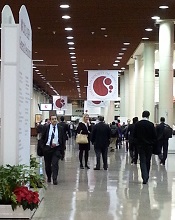
Convention Center, site of the
2013 ASH Annual Meeting
NEW ORLEANS—In a phase 3 study, patients with diffuse large B-cell lymphoma (DLBCL) who received post-induction therapy with enzastaurin saw no improvements in survival over patients who received placebo.
All patients were in their first remission after treatment with R-CHOP, but they were thought to have a high risk of relapse.
The patients who received 3 years of treatment with enzastaurin had similar rates of event-free survival (EFS), disease-free survival (DFS), and overall survival (OS) as patients who received placebo.
Michael Crump, MD, of Princess Margaret Cancer Centre in Toronto, Canada, reported these results at the 2013 ASH Annual Meeting as abstract 371.
Dr Crump noted that enzastaurin is a potent and selective inhibitor of PKCβ, the major isoform expressed in normal and malignant B cells. The kinase is required for signaling through the B-cell receptor, is necessary for activation of NF-κB, and is involved in VEGF-mediated angiogenesis.
“It was a little more than 10 years ago that Margaret Shipp and her colleagues demonstrated that overexpression of PKCβ mRNA and protein was associated with relapsed and fatal diffuse large B-cell lymphoma,” Dr Crump said.
“Since that time, other investigators have also shown that overexpression of either protein or mRNA is associated with a worse outcome in patients receiving CHOP chemotherapy as well as R-CHOP. So [PKCβ] seems to be a rational therapeutic target.”
With this in mind, Dr Crump and his colleagues conducted the phase 3 PRELUDE trial, comparing enzastaurin to placebo in DLBCL patients.
Patient population
The researchers enrolled 866 patients who had a complete response, unconfirmed complete response, or negative FDG-PET scan following treatment with R-CHOP14 or R-CHOP21.
The team randomized 758 of the patients to receive placebo or oral enzastaurin at 500 mg once daily, with a 1125 mg loading dose on day 1. A total of 263 patients in the enzastaurin arm and 129 patients in the placebo arm completed 3 years of treatment.
The rates of discontinuation were similar between the arms—46.7% (n=230) in the enzastaurin arm and 48.2% (n=120) in the placebo arm. In both groups, the most common reason for discontinuation was disease progression (n=103 and 60, respectively). Adverse events were the second most common reason (n=72 and 28, respectively).
Baseline characteristics were similar between the 2 groups. The median age was 64, most patients were Caucasian, most had an ECOG performance status of 0, most had stage IV disease, and more than half of the patients in each arm were PET-negative (although about 40% of patients in each arm did not have a PET scan).
Survival outcomes
The 2-year OS rate was 87% in the enzastaurin arm and 89% in the placebo arm. The 4-year OS rates were 81% and 82%, respectively. And the hazard ratio was 1.04 (P=0.807).
The 2-year EFS rate was 78% in the enzastaurin arm and 73% in the placebo arm. The 4-year EFS rates were 69% and 70%, respectively. And the hazard ratio was 0.90 (P=0.460).
The 2-year DFS rate was 79% in the enzastaurin arm and 75% in the placebo arm. The 4-year DFS rates were 70% and 71%, respectively. And the hazard ratio was 0.92 (P=0.541).
The researchers also assessed DFS according to cell of origin. And they found no difference between patients who had germinal center B-cell (GCB) DLBCL and patients who did not.
Overall, the hazard ratio for GCB vs non-GCB DLBCL was 0.92 (P=0.74). In the enzastaurin arm, the hazard ratio was 0.77 (P=0.40). And in the placebo arm, the hazard ratio was 1.31 (P=0.54).
“One would anticipate a drug that interferes with B-cell receptor signaling might have benefitted patients with tumors that are not of germinal center origin,” Dr Crump said. “Altogether, however . . ., there was actually no difference in GCB vs non-GCB, in terms of outcome.”
“Perhaps [the patients] being in a complete response is one of the reasons why we don’t actually see a difference in outcomes,” he added. “These are all patients who’ve had very good responses to their primary treatment.”
Adverse events
Dr Crump said there were a number of adverse events that could be related to enzastaurin treatment.
Chromaturia occurred in 18.5% of patients in the enzastaurin arm and 0.4% of patients in the placebo arm (P<0.001). Prolonged QT interval was an issue in 10.8% and 3.6%, respectively; diarrhea occurred in 10.3% and 2.8%, respectively; and discolored feces arose in 7.7% and 0%, respectively (P<0.001 for all).
Other adverse events (occurring in 5% of patients or greater) included neutropenia, rash, fatigue, and nausea. But the rates of these events were similar between the treatment arms.
Dr Crump noted that these results are consistent with the established safety profile of enzastaurin when it’s used as a single agent in lymphoma and other cancers.

